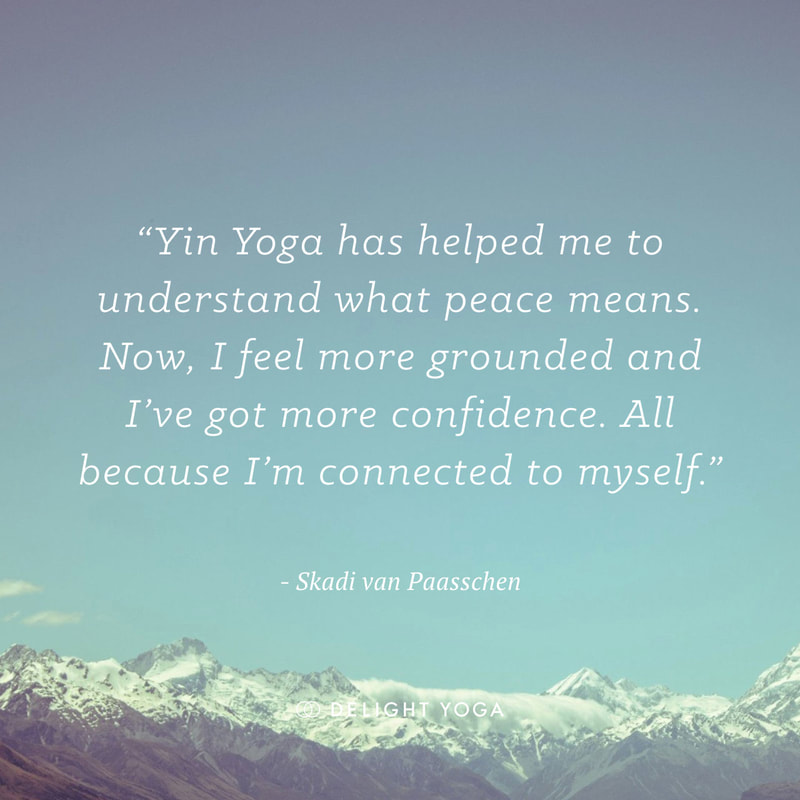|
But first, a yin yoga description: Unlike other types of yoga that are more dynamic and that work on the muscles to develop stamina, strength and fitness (think Bikram, vinyasa or ashtanga); yin yoga is a unique style comprised of seated or lying poses that work predominantly on the tendons, ligaments and fascia of the hips, legs and lower back; enabling deep release of tension, improved circulation and flexibility.
The poses are typically held for between 2 and 5 minutes and the pacing and transitions are slow. The idea is to stretch deeply and to then hold the stretch, finding and staying with your ‘edge’ in the pose, which can sometimes feel intense, but will result in enhanced flexibility and a feeling of ease and lightness in the body. Yin Yoga Benefit #1: Releases Deeply Held Tension in the Body Yin yoga is of particular benefit to tense bodies, because of its direct lengthening and releasing effect on the fascia. Once thought to be of little consequence to anatomists and health care professionals alike, research is now showing how these sheets of connective tissue, when subject to repetitive movements or poor posture, can shorten and tighten in ingrained patterns around muscles. This can equate to chronic tightness and muscle tension, increased chances of injury and even poorer posture. The incredible thing about fascia is, because of its inter-connectivity throughout the body, simply by working on a few key areas highly dense with fascia –such as the lower body in yin yoga – the fascia is able to release all over. In other words, even if you feel tight in the shoulders, by working the hips or lower spine in yin yoga, you can get release in the upper body as well! Yin Yoga Benefit #2: Complements Other Workouts The ancient Chinese concept of yin and yang relates to the notion that within two opposing forces, there is interdependence, connectivity and balance. How does this relate to your workout? Certain styles of exercise can be classified as either yin or yang according to their inherent qualities. Yang style workouts (like running, most sports or dynamic yoga) are so-called because they are active, sweat-inducing, heat-building, dynamic and repetitive. The Yang principle relates to masculinity, heat, movement and force. Yin is the feminine force and relates to stillness, rest, balance, cooling and release. Exercises that are based on stretching and relaxation are therefore said to be yin in nature. If yang-style workouts are overused without balancing them with something complementary like yin yoga, there is the potential for the body to become overworked, injured or fatigued and for the practice to become egocentric and overly-based on reaching physical goals. Bringing in some yin yoga to your exercise routine will balance this with improved flexibility, balance and relaxation. Yin Yoga Benefit #3: It Balances Your Chi According to traditional Chinese medicine, our bodies are powered by a vital force called chi that runs through specific energetic channels in the body called meridians. Several experts have theoretically supposed that while the fascia are not the meridians per se, they could be intricately connected to them due to their chi-like fluidic and electrical properties. While any yoga style could have an effect on the meridian pathways to a degree, yin yoga works intensely on the fascia and may therefore have a more profound effect on the meridians. All of the meridians at some point flow through the back and legs, so different yin postures can effect certain meridians and classes may be structured to utilise this effect, either by choosing poses that work on all of the meridians, or by choosing to structure a class to focus on just a couple. Yin Yoga Benefit #4: It Calms the Mind & Enhances Meditation The deliberate, slow pacing and long holds in yin yoga make it an ideal segue into turning the attention within and developing some of the other branches of yoga such as pratyahara (withdrawal of the senses) and dhyana and dharana (concentration and meditation). At the very least, it helps to cultivate both stillness and mindfulness as the practitioner must stay within often very intense poses, and bear witness to the sensations as they occur. Mindfulness practice has been scientifically proven to reduce stress and anxiety and to improve mental cognition, concentration and clarity. |
Author's MessageEl amor es la esencia de nuestra vida. He escrito este blog con amor, y te lo ofrezco, querido lector, con la esperanza de que las sugerencias que se ofrecen aquí se conviertan en una parte vital de su autocuración y bienestar continuo. Categories
All
Archives
December 2023
|


 RSS Feed
RSS Feed
